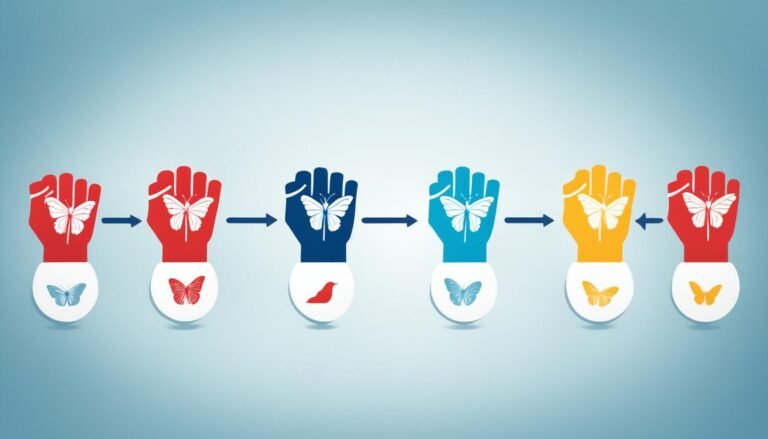How do effective managers manage their stakeholders?
Proper stakeholder management is key for project success and gaining an edge over competitors. Many managers find it hard to engage and manage their stakeholders well. They should use strategies and tools like stakeholder management strategies, stakeholder engagement techniques, stakeholder communication methods, stakeholder relationship building, stakeholder influence tactics, stakeholder analysis tools, and effective stakeholder management practices.These can lead to better outcomes and project success.
Key Takeaways:
- Effective stakeholder management is crucial for project success and competitive advantage.
- Implementing various strategies and techniques can help managers engage and manage stakeholders more effectively.
- Stakeholder analysis, mapping, and communication tools play an important role in stakeholder management.
- Building trust, keeping stakeholders engaged, and managing expectations are key elements of successful stakeholder management.
- By prioritizing stakeholder management, managers can enhance project outcomes and achieve their goals.
Identify All The Stakeholders At The Beginning Of The Project
Effective stakeholder management starts by identifying these parties early on. We should include anyone or any group that ties to the project. This step makes sure the project team meets the needs of these key people.
A project’s stakeholders can be many. For example, there are project managers, sponsors, team members, customers, suppliers, and others. Each has a different part to play. Knowing who they are is key to running a project well.
Figuring out the main stakeholders is important. It helps us see how they might affect the project. This way, project managers can plan how to work with them all. This makes the road smoother for everyone involved.
“Stakeholder identification is like putting together a puzzle; each stakeholder plays a significant role in shaping the project’s outcome.”
The Importance of Stakeholder Roles and Impact
It’s key to know what each stakeholder should and can do. This helps divide the work in a smart way for the project’s success. Project managers use this info to use everyone’s skills just right.
Also, we need to see who can really make a difference. They might need extra attention. And, they might need special ways to keep them happy and involved in the project.
Stakeholder Mapping for Clear Understanding
Stakeholder mapping helps show who influences what in the project. This visual tool guides project managers. It helps figure out who to focus on first.
With mapping, you can group stakeholders. This groups them by their power, interest, and help for the project. Then, project managers can talk to them in a way that suits each group best.
Example: Stakeholder Identification Matrix
| Stakeholder | Role | Impact |
|---|---|---|
| Project Managers | Oversee project planning and execution | High |
| Sponsors | Provide funding and resources | High |
| Team Members | Execute project tasks | Medium |
| Customers | Receive project deliverables | High |
| Suppliers | Provide necessary materials or services | Medium |
| Regulatory Agencies | Enforce compliance requirements | High |
By finding, understanding, and working with stakeholders correctly, a project can do better. It helps everyone know the project’s goals and work towards them together.
Ensure All The Stakeholders Agree On The Project’s Deliverables And What Their Roles Are
Key to managing stakeholders well is ensuring they all agree on what the project aims to deliver. It’s done by using strategies that encourage working together. This means talking a lot and making sure everyone is on the same page.
When everyone knows the project’s goals and what they need to do, everything runs more smoothly. This understanding prevents fights, clears up mistakes, and helps the team meet their goals on time.
It’s really important to let stakeholders help make decisions and listen to what they have to say. This shows we value their knowledge and care about what they need. They feel important this way.
Good team talks are what keep everyone happy. Sharing news, updates, and meeting often for chats means everyone feels part of the team. This builds trust and makes sure everyone understands what’s going on.
Benefits of Stakeholder Agreement:
- Improved project outcomes: When everyone knows their part and goals, projects succeed more often.
- Increased stakeholder satisfaction: Making sure the project matches what they wanted makes stakeholders happier and more supportive.
- Efficient decision-making: Agreed roles make choosing the right path faster and easier, with less confusion.
- Enhanced teamwork and collaboration: Working toward common goals because everyone agrees makes for a stronger, more united team.
Getting everyone on board with the project’s aims and roles is crucial for success. It’s about talking, working together, and ensuring everyone knows what’s expected. This is the foundation for great projects.
For more tips on handling project changes and improving communication in stakeholder management, keep reading.
Get Consensus On How To Handle Changes To The Project
Changes happen in every project. Managing them well is key to project success. It’s vital to get everyone to agree on how to deal with these changes. This ensures all work towards the same goals.
Key to managing change is to keep talking. Open and proactive communication is a must. We need to tell everyone if the plan changes. This keeps trust and keeps people involved. It answers any questions they might have.
“Effective change management requires involving stakeholders in decision-making processes.”
When dealing with project changes, it’s crucial to get input from stakeholders. This way, we get different perspectives. And we make sure everyone’s needs are considered when making decisions.
“Transparency and addressing concerns are key to navigating project changes smoothly.”
Listening to concerns is vital. We should hear what stakeholders worry about. Then, we can explain and find solutions. This reduces their resistance to changes and gets their support.
Being open through all change steps is essential. Sharing updates and reports helps everyone understand the reason for the changes. It builds trust and minimizes conflicts and pushbacks.
“Open and transparent communication is crucial for managing project changes effectively.”
Good change management includes regular project updates and meetings. Use different ways to communicate, like emails or software. This makes sure information moves well and everyone can talk.
“Successfully managing project changes requires stakeholder consensus and effective communication channels.”
To manage changes well, everyone should agree and talk. Including stakeholders in decisions, being clear, listening to worries, and good communication are vital. This way, project changes can go smoothly with everyone on board.
Practice Good Communication
Good communication is key to stakeholder management. It’s important to set up clear lines of communication. This keeps everyone up-to-date and focused on the project’s goals. With effective communication strategies, project managers can make sure everyone is working together well.
Start by deciding how often and in what way to communicate. Updates, reports, and meetings are perfect for keeping stakeholders informed. Presenting information clearly and quickly can help solve any worries.
“Communication works for those who work at it.” – John Powell
Meeting stakeholder needs and worries helps build their trust. Listen to them actively, show empathy, and value their ideas. This makes everyone work better as a team and strengthens relationships.
Being open and honest in communication is crucial. It lets stakeholders know the project’s goals, challenges, and wins. Plus, sharing updates regularly keeps everyone on the same page.
Letting stakeholders join the conversation and share their thoughts is essential. Encourage them to ask questions and bring their ideas. This way, they truly feel part of the project’s journey.
Benefits of Good Communication in Stakeholder Management
Using the right communication strategies can do wonders:
- Stakeholders feel more involved and satisfied.
- There’s more trust and understanding.
- Collaboration improves.
- Resolving conflicts becomes easier.
- Everyone knows the project’s goals and what’s expected.
Good communication makes for a positive project setting. It gets stakeholders on board with the project’s vision. Throughout the project, keeping everyone informed and involved can lead to success.

| Effective Communication Strategies for Stakeholder Engagement | Benefits |
|---|---|
| Regular updates and progress reports | Keeps stakeholders informed and engaged |
| Clear and concise presentations | Conveys important project information effectively |
| Active listening and empathy | Builds stakeholder trust and strengthens relationships |
| Open and transparent communication | Increases stakeholder understanding and reduces uncertainty |
| Encouraging stakeholder participation | Fosters collaboration and promotes stakeholder contributions |
Keep The Project Vision Visible
It’s key to keep the visibility of the project vision high. Everyone involved needs to understand the project objectives, goals, scope. They should know about any changes too. Being transparent and offering clear communication makes this possible. This builds trust and ensures everyone is on the same page. It helps the project succeed.
To ensure everyone sees the project vision properly, it is crucial to:
- Explain the project’s vision and goals right when you start. Make sure everyone involved knows about them.
- Keep updating stakeholders on how close or far you are to achieving the project vision.
- Tell them about any changes to the project vision as soon as they happen, and do it clearly.
- Let stakeholders talk about the vision. Offer them chances to give feedback and ask questions.
Being open and keeping up with communication links stakeholders to the project vision all the time. It shows how their help adds up to the project’s success. This method grows their sense of commitment and of owning the project’s results.
Stakeholder visibility improves a lot by keeping the project vision in sight. It encourages stakeholders to really take part in achieving the project’s goals. Plus, it fosters a culture where everyone feels they play a part.
| Benefits of Keeping the Project Vision Visible: |
|---|
| 1. Stakeholder alignment and buy-in |
| 2. Enhanced project focus and direction |
| 3. Increased stakeholder engagement and motivation |
| 4. Improved decision-making based on shared understanding |
Engage Stakeholders Throughout The Process
Effective stakeholder engagement is key to managing projects well. By including stakeholders at every step, organizations get useful ideas and ensure the project succeeds. Ways to boost engagement and promote project teamwork include:
Involving Stakeholders in Decision-Making Processes
Including stakeholders in decisions makes them feel part of the project. Their early involvement lets them voice their opinions, helping to avoid disagreements later. This method means decisions meet stakeholder needs and are well-informed.
Seeking Stakeholder Feedback
Getting feedback from stakeholders offers valuable insights. By involving them in reviewing progress and plans, you refine strategies and solve new issues. This way, stakeholder involvement increases and problems are dealt with promptly.
“Continuous engagement with stakeholders is critical to building trust, fostering collaboration, and achieving project success.”
Celebrating Milestones Together
Marking project success is a great way to keep stakeholders involved. It shows their efforts are valued and keeps them motivated. Celebrations and recognitions can improve project atmosphere and encourage further participation.
The Power of Collaboration
When stakeholders actively help make decisions and share their expertise, projects thrive. It brings diverse ideas and problem-solving together. This method builds teamwork and shared responsibility, which leads to successful projects.
By focusing on stakeholders in decision-making, seeking their feedback, celebrating success together, and encouraging teamwork, projects become more successful. Involving stakeholders keeps them committed and creates a positive atmosphere for projects. This approach leads to better project outcomes and satisfied stakeholders.
Manage Expectations for Stakeholders
One big part of managing stakeholders well is keeping their expectations in check. This is key for a project to run smoothly. By clearly discussing the project’s scope, goals, deadlines, and what needs to be done, we avoid confusion.
It’s crucial to make clear who does what among the stakeholders. This stops any misunderstandings and helps the project flow better. Having a set timeline shows what’s realistic and keeps everyone on the same page about how things are going.
A good plan for communicating is crucial for handling what stakeholders expect. This means picking the best way to talk, how often to update, and what to tell them. Keeping everyone in the loop makes sure they’re happy with how the project is moving ahead.
“Clear communication is the key to managing stakeholder expectations. By setting realistic goals, sharing progress updates, and involving stakeholders in decision-making processes, we can create a collaborative project environment.”
When project managers are careful about what they tell stakeholders, everyone’s happier. If stakeholders understand the project’s aims, what it includes, and the schedule, they can offer useful advice. This support helps the project reach its goals.
Consider this table to see why it’s vital to handle what stakeholders expect:
| Stakeholder | Expectations | Actions |
|---|---|---|
| Client | High-quality deliverables within the specified timeframe | Regularly update the client on the project progress and address any concerns promptly |
| Team Members | Clear instructions, timely feedback, and opportunities for growth | Provide clear instructions, regular feedback, and identify opportunities for professional development |
| Management | Projects aligned with organizational goals and within budget | Regularly communicate the project’s alignment with organizational goals and financial updates |
Managing stakeholder expectations takes being ahead of the game in how you share info and involve others. This way, project managers build trust and teamwork. This contributes a lot to the project’s success.
Conclusion
Managing stakeholders well is key to project success. This means identifying them, agreeing on goals, welcoming their input, and keeping everyone informed. Doing this helps build trust and teamwork.
When stakeholders are properly managed, misunderstandings are less likely. Everyone knows their part, what to expect, and how they can help. This smooths things out and pushes the project ahead.
Keeping people in the loop and being open are vital. It makes stakeholders feel valued and connected to the project. This builds their confidence and a shared desire to see the project do well.
To sum up, handling stakeholder expectations well can lead to big wins. It’s about creating a positive, team-focused environment. There, projects thrive and everyone involved wins for the long haul.
FAQ
What is stakeholder management?
Stakeholder management is about dealing with people or groups who can influence or are impacted by a project. It uses certain ways to meet their needs, consider their views, and build cooperation. This helps create a positive project atmosphere.
Why is it important to identify stakeholders at the beginning of a project?
It’s key to spot stakeholders early on as it shows their importance and how they affect the project. This makes sure everyone has a say and their needs are heard. Doing this early boosts the project’s chances of doing well.
How can stakeholders be engaged throughout the project?
Engaging stakeholders means bringing them into decisions, getting their thoughts, and sharing project wins. This makes them feel part of the project, boosting their commitment. It often leads to better results for everyone.
How can changes to the project be effectively managed?
Managing project changes well involves getting stakeholders to agree on any changes. Keeping them in the loop and part of the decision-making helps a lot. This ensures everyone is on the same page, even when things adjust.
How important is good communication in stakeholder management?
Great communication is at the heart of good stakeholder management. It keeps people in the loop, decides how often and how to talk, and looks after their needs. This builds a stronger team, leading to a better project outcome.
How can stakeholder expectations be managed?
To handle what stakeholders expect, it’s vital to lay out the project clearly. This includes its goals, steps, deadlines, and what it’s set to achieve. Defining who does what, setting clear times, and having a way to talk keeps things on track.








